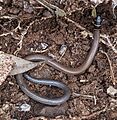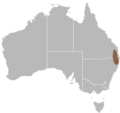Collared delma facts for kids
Quick facts for kids Collared delma |
|
|---|---|
 |
|
| Conservation status | |
| Scientific classification | |
| Genus: |
Delma
|
| Species: |
torquata
|
 |
|
The collared delma or adorned delma (Delma torquata) is a tiny lizard found only in Australia. It belongs to the Pygopodidae family. These lizards are special because they don't have legs, so people often mistake them for snakes!
Collared delmas live mostly in southeast Queensland and northern New South Wales. You can find them in forests and even some suburban areas. They are active during the day, looking for small insects to eat.
Contents
What Does It Look Like?
The collared delma has different colors on its body. Its tail and body are usually bluish-grey or brown. Its head is black with cream or yellow rings. These rings are a special feature of the collared delma. It usually has one ring around its head and two or three rings around its neck.
This small lizard is about 50 to 70 millimeters long from its snout to its vent (a body opening). Its tail is much longer, from 103 to 126 millimeters. On average, a collared delma weighs only about 2.5 grams.
Its Scales
Like all lizards in the Pygopodidae family, the collared delma has scales that overlap. Its body has 16 rows of these scales.
Where Do They Live?
Where They Are Found
Collared delmas are mostly found in southeast Queensland. They have also been seen in northern New South Wales. Because they are vulnerable, their homes in Queensland are spread out and in small, separate areas.
These areas include places like the Bunya Mountains and Blackdown Tablelands National Park. You can also find them near Toowoomba. Many collared delmas live in the western suburbs of Brisbane, such as Kenmore and Karana Downs.
Their Home
In Queensland, collared delmas mainly live in woodlands with eucalypt and acacia trees. They also like open forests. They prefer to live on west-facing hillsides. You can often find them under a layer of fallen leaves and loose rocks.
Trees Above Them
The types of trees above where collared delmas live can change. In the eastern parts of their range, you might see silver-leaved ironbark or Moreton Bay ash trees. West of Brisbane, the trees include red ash and different kinds of wattles.
Grass and Soil
Collared delmas don't prefer one specific type of soil. They can live in sandy soil, clay, or rocky soil. For example, in Mt Crosby, they are found in stony soil. In other areas, they live in soil with basalt rocks.
The ground where they live is usually covered with grasses. These include kangaroo grass, barbed-wire grass, and wiregrass. You might also find plants like Lomandra.
Their Tiny Homes
A collared delma's tiny home, called a microhabitat, often includes logs, rocks, and pieces of bark. The layer of leaves on the ground where they live is usually between 30 and 100 millimeters thick.
What They Do
Breeding and Babies
Like all pygopodid lizards, collared delmas have their breeding season in the Australian summer. The females lay two eggs in December. These eggs hatch in late February or early March.
What They Eat
The collared delma is an insectivore, which means it only eats insects. They like to eat small cockroaches and spiders. They are active during the day, always looking for food. They have only been seen hunting alone.
Protecting the Collared Delma
Why They Are Vulnerable
The collared delma is listed as a vulnerable species. This means their numbers are decreasing, and they need protection. We don't have exact numbers for how much their population has dropped. However, they are rarely seen, and their habitats are broken up.
Their biggest threats come from humans. This includes clearing land for buildings and farms. Other dangers are removing rocks and leaves from their habitat. Chemicals used in farming, attacks by feral cats and foxes, and invasive weeds also harm them.
What Is Being Done to Help
People are working to protect the collared delma's home. Local governments are watching and protecting areas where these lizards live. They also try to make sure that road building doesn't disturb the lizards' environment. The public is asked not to remove rocks from areas where collared delmas might live.
Fires
The Queensland government has rules about fires. These rules help protect the homes of all animals, including the collared delma.
Invasive Weeds
People are encouraged to find and remove invasive weeds, like dwarf lantana. Getting rid of these weeds helps reduce the threat they pose to the collared delma.
Images for kids




